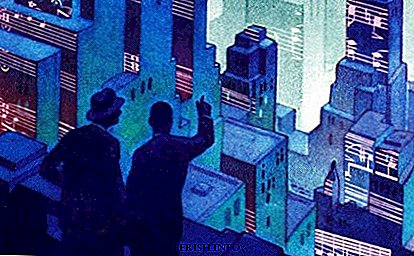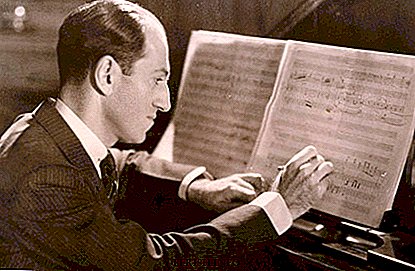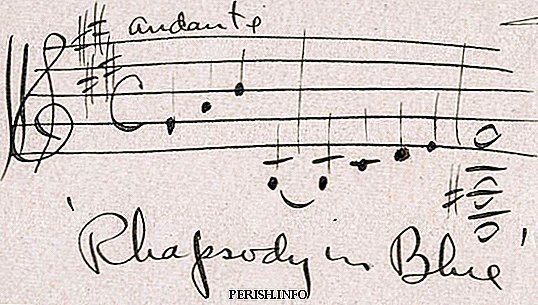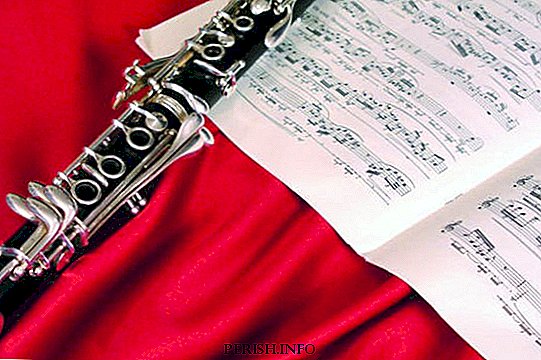D. Gershwin "Rhapsody in Blues Style" (Blue Rhapsody)

The history of world music culture is known to many composers who, with their creativity, have made a significant contribution to the development of this type of art. One of these innovators was George Gershwin, the first to compose a piece in which a symphony orchestra made the blues play and thereby created a kind of miracle. “Blues Rhapsody” is the name of an outstanding work that has become a revolutionary slogan taken up by composers around the world.
History of creation
The history of the famous work began in the twenties of the last century. Late in the evening on January 3, 1924 George Gershwin with their older brother Ira and their mutual friend composer Buddy Desilva, they wanted to get some rest. Looking for entertainment, they, walking around Manhattan, looked into one of the billiard clubs. Ira, a little tired of the game, decided to distract himself and, picking up the daily New York Tribune, in the entertainment section, read an interesting message that intriguingly affected all friends. In the announcement, it was reported that on February 12, the birthday of the 16th US President Abraham Lincoln, in the Eolian Hall of New York, Paul Whiteman's orchestra will give a concert with a program in which new American music will be performed. The attention of young people was attracted by the information that the composer Gershwin was enthusiastically working on a jazz concert. This information stunned George, because in three weeks the premiere of his musical “Sweet Little Devil” should take place, and suddenly such news: until February 12, he turns out he should write a new concert. To clarify the situation, the composer, waiting for the morning, called Whiteman. Jazzman explained to Gershwin that this situation made him make such a statement in the press. The fact is that his competitor Vincent Lopez wanted to appropriate the idea of an experimental concert to himself.

At first, George doubted a little, because there was so little time left, but the conductor persuaded him. Gershwin had only to compose a piece for two pianos, while Ferdi Grofe, a talented composer who worked as a full-time arranger in the Whiteman orchestra, would do the orchestration.
Without delay, George immediately proceeded to compose a new work. He worked even when he moved to Boston, where the premiere of his new musical performance was to take place. For example, the main theme of "Rhapsody in the style of blues" was written in a train. So, Gershwin did not write a jazz concert, but a rhapsody — a free-style work for the piano and orchestra, which includes elements of European symphonic music and American jazz.
Initially, the composer called his new creation "American Rhapsody", but Ira, visiting the exhibition of the artist James Whistler and seeing the picture "Nocturne in Blue and Gold: Old Bridge in Battersea," advised his brother to call the work "Rhapsody in blues tones."
The concert, which provided an opportunity to listen to "experiments in modern music," attracted the attention of many prominent musicians. In the New York Eolian Hall on February 12 you could meet Sergey Rakhmaninov, Fritz Kreisler, Yashu Heifetz, Leopold Stokowski and Igor Stravinsky. The program included works by various authors, but their essays were not admired by the public. Enthusiastic excitement went around the hall only when George Gershwin was seated at the piano and the first sounds of his Rhapsody sounded. The musician played so that the listeners of emotions from tears rolled. At the end of the work, a storm of applause swept the hall, and on the next day of publication in the newspapers vigorously praised Gershwin's talent.

Interesting Facts
- Initially, George Gershwin, the famous opening clarinet passage from the "Rhapsody", composed in the form of a seventeen-note scale. However, the performance of Ross Gorman, who played the last glissando notes at the rehearsal of the piece, attracted the composer's attention, and it was this version that was recorded in the score.
- The popular "Rhapsody" Gershwin has a lot of options for arranging. For example, one day George Gershwin's brother Ira heard the famous work of his brother performed by the banjo-octet and received a very negative impression from such instrumentation.
- Eminent american Jazzman Duke Ellington Gershwin liked the "Rhapsody" so much that he several times did various instrumentation of this piece for his jazz band.
- Very little time was allotted for Gershwin’s composition of the “Rhapsody”, something he didn’t even have time to write on musical paper. For example, on the premiere performance of a piano part, the author played from memory.
- At the time when Gershwin composed “Rhapsody”, he was only 25 years old, however, he managed to establish himself in musical theaters on Broadway, as he was the author of music for a dozen performances. The announcement that he was the one who wrote the new work caused a keen interest in Whiteman's experimental concert.
- To date, two recordings of the "Rhapsody" have been preserved, in which the author himself plays solo piano. One is dated June 1924 - Gershwin plays with the Whiteman Orchestra, and the other, in April 1927, with the orchestra conducted by Nathaniel Shilcret.
- Gershwin's music "Rhapsody in the Blues Style" directors are often used in animated films and films. A striking example is the full-length animated film "Fantasia 2000", as well as Woody Allen's films "Manhattan" and The Great Gatsby Lurman's Base.
- Gershwin's Rhapsody sounded at the opening ceremony of the 1984 Summer Olympics in Los Angeles. For the simultaneous performance of the work 84 pianists were invited.
Content

Gershwin's writing is a rhapsody in the full sense of the word. Her musical material, not enclosed in the strict framework of a musical form, but alternating in a free sequence, is colored with blues intonations characteristic of Negro music. The melodic material of the work includes several themes of contrasting nature, which are constantly subjected to variational transformations. It all starts with a spectacular dvuhktavnogo glissando clarinetleading to the first theme, the peculiar character of which is given by the lower stages of melodic major and syncopated rhythm. Second theme performed trombone and horn, has a pronounced bluesy sound, as it is emphasized with lowered 3 and 7 steps. After the pipe The third theme, and the fourth - tutti of the whole orchestra, the virtuoso improvisations of the pianist, based on all the previous musical material, come to the fore. Further, in the work, there appear not only motifs sounding earlier, but also new ones, for example, an expressive chanting and lyrical theme, which then will be transformed with talent into a windup tokatu. In the final of the rhapsody, the composer, using the preceding themes, displayed a jubilant holiday, the fun of which has no limits.
Outstanding work George Gershwin "Rhapsody in the style of blues" is currently the most performed work composed by an American composer. Today, as well as in the twenties of the last century, it remains interesting and exciting for the audience.

Leave Your Comment